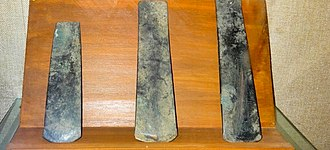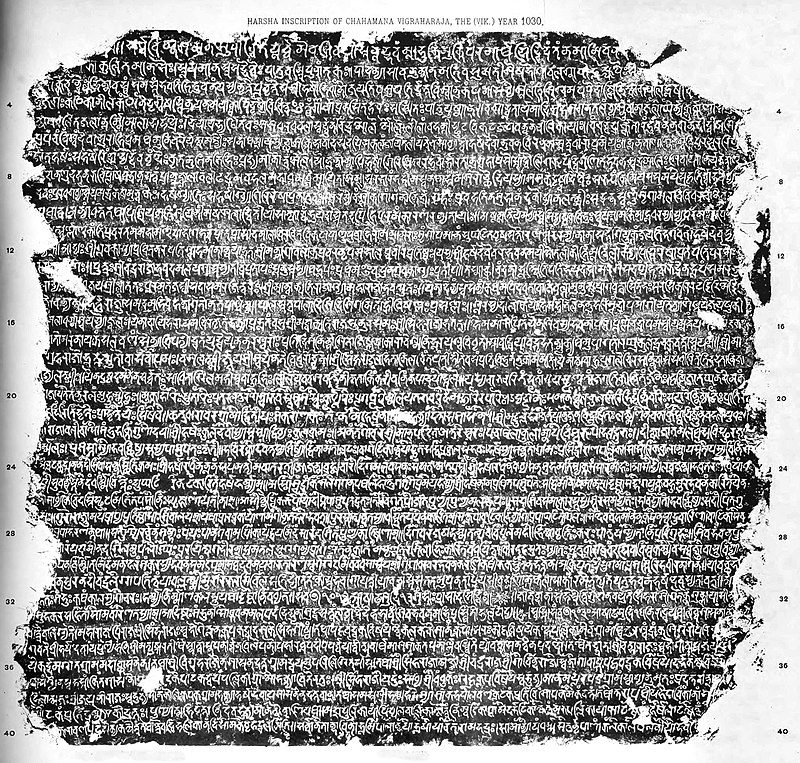Skip to content
Inscription
- Barli Inscription(Ajmer) – 443 BC

- Found: Bhilott Mata Temple(Village – Bhinaika, Ajmer)
- Written in sanskrit language in the Prakrit script
- Note:
- The Barli Inscription was the oldest/ancient inscription of Rajasthan.
- India’s oldest inscription→ Piprahwa Inscription(U.P)-487 BC
- It is one of the earliest Jain inscriptions excavated from Rajasthan in 4th-5th century BC.
- Inscription contains the line “Viraya Bhagavate Chaturasiti Vase”
- Discovered by Gauri Shankar Hirachand Ojha(G.H Ojha)
- Ghosundi Inscription(or Hathibada Inscription) – 2nd-1st BC

- Found: Nagari(Chittorgarh)
- It is the oldest known Sanskrit inscription in the Brahmi script.
- Ghosundi Inscription gave information about Vaishnavism in India in 2nd BC.
- Existence of Krishna and Balarama have been mentioned in the first three lines of the Ghosundi inscription.
- According to the inscription, King Sarvatata of Gaja Dynasty performed Ashwamedha Yagya.
- Dr. D.R Bhandarkar read it.
- Nandsa Yup Stambh Inscription ( Bhilwara ) – 225 AD
- Found: Nandsa Village(Bhilwara)
- Written in sanskrit language
- Established by Soam
- Barnala Yup Stambh Inscription ( Jaipur ) – 227 AD
- Found: Barnala( Jaipur)
- Written in Sanskrit
- Mention of seven schools made by Soharan King
- Badwa Yup Stambh Inscription ( Baran ) – 238 AD
- Found: Badwa( Baran )
- Written in Sanskrit language in the Brahmni script
- Information:
- Maukhari dynasty
- Three brother’s Balavardhan, Somdev and Balsingh performed Triratra Yagya
- Bichpuriya Inscription (Tonk)- 274 AD
- Found: Bichpuriya( Tonk )
- Yajna performed by Sage Agnihotra in Malwa region.
- Vijayagarh Yup Stambh Inscription – 278 AD
- Found: Vijaygarh
- Information:
- Pundareek Yajna performed by King Yashovardhan
- Gangadhar Inscription( Jhalawar ) – (423 – 424 AD)
- Written in Sanskrit language, during the reign of Aulikara King Visvavarman.
- Information:
- Lord vishnu temple and mother goddesses
- Stepwell built by Mayurakash, a minister of King Vishwakarma.
- Feudal system
- The text of Gangadhar inscription was edited and published by John Faithfull Fleet in 1888.
- Nagri Inscription ( Chittorgarh ) – 424 AD
- Excavation done by D.R Bhandarkar
- Written in Sanskrit, Devanagari script
- Information:
- Worshiping of Lord Vishnu
- Bharmar Mata Inscription ( Chittorgarh )- 490 AD
- Found: Choti Sadri
- Information:
- Gaur dynasty
- Khand Inscription ( Chittorgarh ) – 6th AD
- Information:
- About Vishnudatta(as a good merchant) and his son as a Rajasthaniya an officer deputed by the King.
- Abhaya Dutta as Rajvanshiya ruler.
- Basantgarh Inscription( Sirohi ) – 625 AD
- Raja Varmlaat was ruler of Arbudh Region(Abu Region).
- Found at Shremkari Mata temple
- Gives information about Samanta system(feudal system)
- Varmlaat was ruler of Chavda/Chap dynasty
- Capital of Chavda→ Bhinmal
- In this inscription, Vajrabhatt’s son Raulji was considered as master of Arbudh Country.
- Shamboli Inscription( Udaipur ) – 646 AD
- Written in Sanskrit language
- Information:
- Victories of Guhil King Shiladitya.
- Jetak, a man from Vatnagar, set himself ablaze as a religious tradition.
- At this time mining work at Jawar got started for Zinc and Copper
- Dr. Ojha put it into the Ajmer Museum.
- Nadi Inscription of Aparajit(Nagada- Udaipur) – 661 AD
- Found: Kundeshwar temple
- Written in Sanskrit language
- Dr. Ojha found it in Kundeshwar Temple(Nagda), put it into Victoria hall, Udaipur museum.
- Information:
- Victory of King Aparajit against a ruler Varah Singh.
- Seventh Century’s religious and political situation of mewar
- Construction of Vishnu temple.
- Mandore( Jodhpur ) – 685 AD
- Found: Bawadi(Stepwell) in Mandore, Jodhpur
- Information:
- Worship of Shiva and Vishnu by Madhu Brahmin.
- Maan Mori Inscription( Chittorgarh ) – 713 AD
- Found: On a pillar at the shore of lake mansarovar(Shankaraghatta, Chittorgarh)
- Written in sanskrit language
- Col. James Todd founded it.
- Information:
- Amrit Manthan.
- Raja Mann Mori
- Todd mention about this inscription on “Annals and Antiquities of Rajasthan”
- Also known as Shankar Ghanta Inscription
- Kansava Inscription ( Kota ) – 738 AD
- Found at shiva temple in Kansava village
- Written in sanskrit language
- Information:
- About King Dhaval of Mauryan Dynasty
- After this inscription there is no other mention about any mauryan kings in Rajasthan.
- Bauk Inscription(Jodhpur) – 837 AD
- Gives information about Pratihar Dynasty
- Ghantiyala Inscription (Jodhpur) – 861 AD
- Found: Ghantiyala ( Jodhpur )
- Written in Sanskrit language
- Inscription established by Kukuk ruler of Pratihara Dynasty
- Information:
- About pratihar Dynasty
- Mug(Brahmin) was writer, and Krishneshwar was engraver.
- Inscription had two part:
- 1st part: Pratihar King Kukkuk freed Ghantiyala from Abhirs of Marwar and established a well organized city.
- 2nd part: about one caste of Brahmins, that shows Prevalence of Varna Division.
- Osian Inscription( Jodhpur ) – 865 AD
- Found: Osian(Jodhpur)
- Written in sanskrit language
- Information:
- Affluence of Vatsaraj, given title of Ripudaman
- 4 varnas
- Pratapgarh Rock Inscription – 946 AD
- Sanskrit language
- Information:
- About Pratihar Dynasty
- In the region of BhartraBhatt 2, a sun temple of Indra Raja Aditya Dev was built
- Name of the farm field was decided on the basis of nearby trees.
- Rock inscription of Chittorgarh – 971 AD
- Found: Chittorgarh
- Now preserve in Bharatiya Mandir(Ahmedabad)
- Information:
- Raja Bhoj and his heirs.
- Construction of Mahavir Jinalaya in Chittorgarh by Raja Narverma.
- Prohibition of women in temple
- Harsha Inscription(Revasa, Sikar) – 973 AD

- Harshnath temple was constructed by Allat.
- In this inscription “Wargat” name was used for the Wagad region.
- Details about Chauhans.
- Devkulika & Shakti Kumar inscription of Aahad – 977 AD
- Information:
- Description of three king: Allat, Narwahan, Shakti Kumar
- Achievement of Allat
- Military system of mewar
- Shakti kumar inscription was taken by Col. Todd to England
- Jhalrapatan Inscription( Jhalawar ) – 1086 AD
- Location – Sarvasukhiya Kothi
- Written in Sanskrit language
- Information:
- Description of king Udayaditya, mentioned that he was a relative of Raja Bhoj Parmar.
- Janak, an oilman, built a temple and step well.
- Engraved by Pandit. Harsukh.
- Kiradu Inscription( Barmer ) – 1161 AD
- Written in Sanskrit language
- Gives information about origin of Parmars from sage Vashishtha Abu Yagna.
- Bijolia Inscription( Bhilwara ) – 1170 AD

- Ruler: Someshwar Chauhan
- Found from Parshwanath Jain Temple
- Architect→ Mahanak
- It’s basically a Digambar Note, which was installed in the temple of Parshavnath by Jain Lolak.
- Bijolia Inscription(Wrote by Gunbhadra) described Chauhan as Vatsh Rishi lineage.
- Information:
- Vasudev Chauhan established the Chauhan dynasty.
- Describe the name history of Jabalipur(Jalore) and gives information about other ancient cities.
- About the pedigree of Chahuhans of Sambhar and Ajmer.
- Sambhar lake was constructed by Vasydev Chauhan.
- Vigraraj – 4 → Delhi Victory
- Kutila river
- Land grant system(Bhumi Anudan)
- Dr. Dashrath Sharma and Dr. Bhandarkar, considered the origin of Chauhans from Brahmins.
- Bijolia Inscription: Composer→ Gunbhaat; Writer→ Keshav; Engrave by→ Govind
- Cheerwa Inscription (Udaipur) – 1273 AD
- Found at Cheerwa Village (Udaipur)
- Sanskrit language in the Nagari script.
- Gives information about Guhil dynasties rulers achievement:
- Padmasingh, Chetra singh, Tejsingh, Smarsingh
- Composer: Ratnaprabha Suri, Writer: Parshv Chand, Engraver: Kelisingh, Architect: Delhan
- Rasia Ki Chatri ( Chittorgarh ) – 1274 AD
- Information:
- About Bapa Rawal to Narverma.
- Achaleshwar Inscription of Abu – 1285 AD
- 62 stanza – Composed by Vedverma has description about Mewar ruler Bapa to Samar Singh.
- Dilwara Inscription ( Sirohi ) – 1334 AD
- Shringi Rishi Inscription – 1428 AD
- Ranakpur Inscription(Pali) – 1439 AD
- Engraved on a Pillar of “Chaumukha temple”
- Sanskrit language in the Nagari script.
- Information:
- Mewar rulers achievement
- Bappa to Kumbha
- Kumbhalgarh Inscription( Rajsamand ) – 1460 AD
- Found in Kumbha Shyam temple of Kumbhalgarh.
- Written in sanskrit language in the Nagari script
- Information:
- Mewar Rulers
- Achievement of Maharana Kumbha
- Such as construction of Kumbhalgarh & temples & stepwells done by Kumbha
- Kumbha Victory
- Rana Hammir–Vishamghati Panchanan
- Kirti Stambh Inscription ( Chittorgarh ) – 1460 AD
- Found: Chittorgarh fort
- Information:
- In this inscription Bappa Rawal has been considered as Brave king and Devotee of Lord Shiva.
- Kumbha brought Idol of Hanuman from Manavyapur( Mandore) and installed it on the main gate of the fort.
- Daanguru, Rajguru, Haalguru are other names used for Kumbha.
- Reveals about Political, religious, social and cultural conditions of Rajasthan in 15th century.
- Mokal- Vishamghati Panchnan
- Jain Kirti Stambh ( Chittorgarh ) – 13th C AD
- Established by Jeejak Jain
- Bikaner Prashasti/Inscription – 1594 AD
- During the reign of Rai Singh, Inscripted at the gate of Bikaner fort.
- Information:
- Mentioned about construction of the fort under supervision of Karmachanda(Minister of Rai Singh).
- Achievement of, from Rai Bika to Rai Singh
- Composed by Jain Muni Jaita(Disciple of Kshemratna)
- Amer Inscription (Jaipur) – 1612 AD
- Reveals about Kachwaha Dynasty of Jaipur and about close relations of Amer with Mughals.
- In it Kachwaha Dynasty is being considered as “Raghuvansh Tillak”
- Clears defines Mansingh was Nephew of Bhagwant Das
- Jamwa Ramgarh Inscription – 1631 AD
- Information:
- Raja Mansingh was the adopted son of Bhagwandas
- Jagannathrai Prashasti/Inscription 1652 AD
- Ruler: Raj singh
- Found: Jagdesh Mandir ( Udaipur )
- Information:
- Haldighati war
- Maharana Jagat singh
- Jagannath mandir
- Provide details about the social system of the 17th century.
- Composed by Krishna Bhatt
- Raj Prashasti ( Rajasmand ) – 1676 AD
- Found: At the shore of Rajsamand lake, near Kankroli(Rajsamand).
- Engraved on 25 marble stones, 1917 Sanskrit verses, about History of mewar.
- Also got the name “Mahakavya”
- World largest sanskrit Prashasti.
- Composed by Ranchor Bhatt
- Shabad Inscription ( Kota ) – 1679 AD
- Information about Aurangzeb’s tax system.
- Buchkala Inscription of Nagabhata(Jodhpur) – 1815 AD
- Ruler: Nagabhata Pratihara-2
- Found at Parwati Mata temple(Bilara tehsil)
- Temple constructed by Panchhari son’s Deyiya
- Discovered by Brahmbhatt Nanuram
Copper Plate Inscription
- Aahad – 1206
- It has the genealogy of Solanki kings.
- Veer Singh Dev 1287
- Naadiya Village – 1437
- Cheekli – 1483
- Inform about Lagaan, Bagri language and method of Partition of fields.
- Battery – 1525
- Pur – 1535
- Vision – 1539
- About the Early years of Maharana Udai Singh.
Additional Information:
- Archeological Survey
- Started in Rajasthan by A.C.L Carlleyle in 1871 AD.
error: Copyright © 2021 AswaTH
